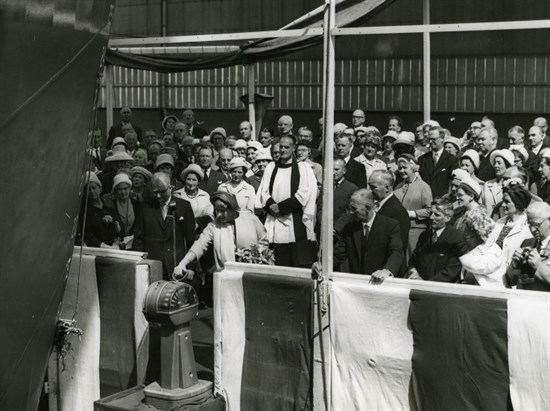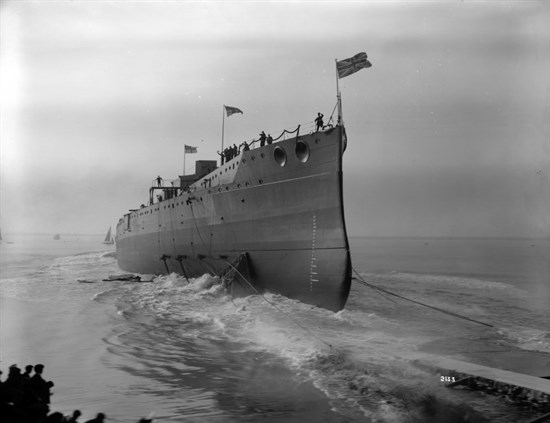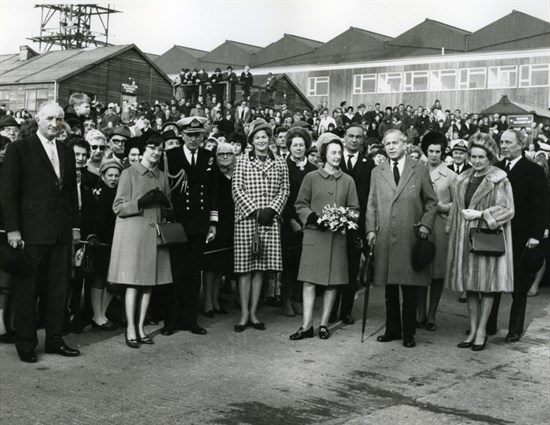Ship Launches
"I name this ship...."
Nobody really knows how the ceremony of launching began but the various ceremonies that have been used worldwide (and some still are) on the decks or the hull have all been associated with the day of a ship’s true birth.
Ship launches in Britain are a solemn blessing and public celebration with many superstitions including christening the vessel with alcohol (usually champagne) and, since the nineteenth century, a woman has the honour of being the vessel's sponsor and thus officially launching it. A chaplain is often present and the Barrow shipyard usually celebrated the day with a special meal for invited guests.
In Barrow, for more than a century vessels have been launched from down a slipway, stern first (the back of the vessel) into the water. A common mistake is to imagine that a vessel has been completed on launch. In fact, the ship is launched when it is watertight and much work is done after launch; this is called fitting out. Additional work could be done to the superstructure after launch but mainly work was done inside the ship i.e. quarters, machinery, boilers, engines, weaponry etc. This process involved plumbers, electricians, joiners, sheet metal workers, engineers and other trades.
The first vessel (not ship) to be launched by the Barrow shipyard, then called the Barrow Shipbuilding Company, was Aries (a steam yacht built for Sir James Ramsden who had helped set the company up).


A Special Day for the Town HMS Vanguard launch
The early years of the twentieth century saw a series of spectacular launches as Vickers, Barrow began to spread its name around the world as a builder of warships.
The battleship Vanguard (pictured left, VPA.2368) was the biggest ship built a Barrow when it was launched on 22nd February 1909. This press report describes the launch and gives a flavour of how the whole town used to participate on launch days:
"Inch by inch it went in at first, to a slow, solemn rumbling of props falling away from under her sides, and the silky squealing of a heavy iron mass moving on greased wood. Then faster and further, till the falling props had almost the rhythm of a boy’s stick on a paling. There was shouting and hat waving from the crowds on either side of the slipways, on the roofs… on the raised platform at the top of the ways, in Walney island beyond and … even from out at sea…The day had been made a general holiday, nearly all the schools had shut… and by common consent seeing the launch was made the business of the day.”
HMS Repulse
HMS Repulse was to be launched at Barrow on 4th November 1967 by Lady Zuckerman (the wife of the Chief Scientific Advisor to the Government). She stayed the night at the company’s guest house, Bankfield in Urswick, as was usual. The Sponsor (Lady Zuckerman) for some reason did not arrive on time at the launch platform. Nevertheless, Len Redshaw, the shipyard manager, decided that the launch could still go ahead and ordered the boat to be named and launched.
Dramatically, Repulse sped away from the tugs up towards the Jubilee Bridge and within a few minutes the boat was aground on the far side of the Channel in the mud. Fortunately little damage was done as that area of the Channel bed was flat and nearly level. The vessel was refloated on the following night tide and entered the dock system safely.
Never again was the Sponsor’s absence allowed to delay trigger release beyond the planned time. When Princess Anne arrived late for the launch of Upholder (due to fog at Walney airport) the decision had already been taken to go ahead without her.


The End of Dynamic Launches
The launch of a vessel at the Barrow shipyard is no longer a gala day for the town but it's still a very important milestone in the life of any vessel and for the shipyard.
By the 1980s, it was clear that the days of dynamic ship launches at the Barrow shipyard were numbered. The dull, but safe, lowering of these hugely expensive and complex submarines was clearly the more sensible option to the always nerve-wracking business of the organised letting-go of a vast vessel into tidal currents.
Naming ceremonies are still carried out, for example HMS Astute was launched by HRH The Duchess of Cornwall, at the Barrow shipyard in 2007 (now called BAE Systems Maritime - Submarines). But now invitations are issues for roll outs, for the exit of the submarine from Devonshire Dock Hall.
